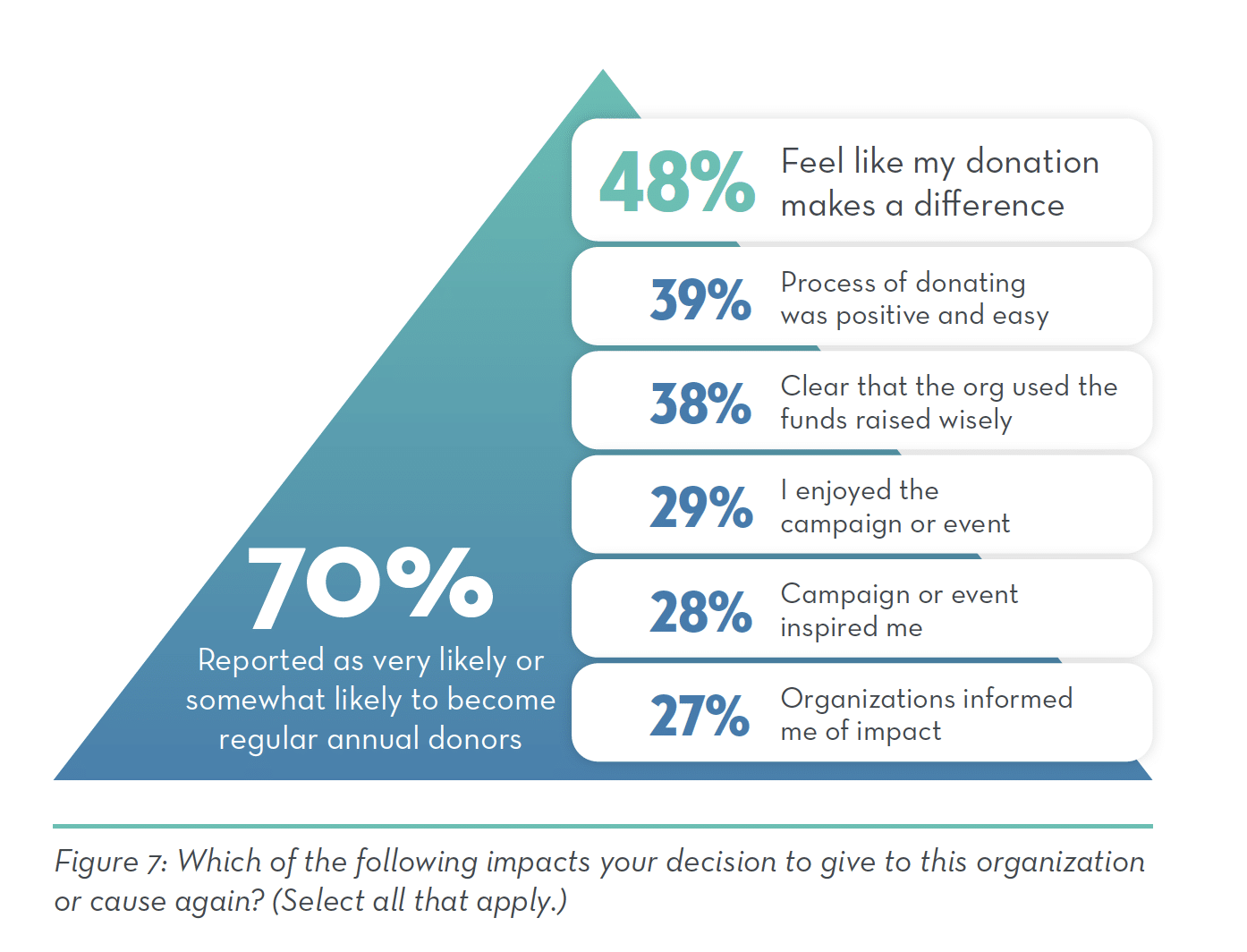What Today’s Donors Want: 8 Facts Every Nonprofit Needs to Know
In the 2023 Giving Experience Study, we examined how generosity has changed and where giving is headed. We asked 1,101 “social donors” what they expect from their giving experience, what motivates them to trust and engage with a nonprofit, and what influences their repeat giving behaviors.
Our goal is to help nonprofits and fundraisers like you navigate and understand what makes today’s donors tick, stick, and stay.
There’s no denying the future of fundraising is a changed landscape. But there’s ways to unlock generosity if we embrace what donors are looking for!
Let’s dive into the 2023 key research findings and how you can use them to create a giving experience that drives giving:
- Things are getting back to “normal.”
- In-person events are back in a big way.
- Mission, trust, and ease share the podium as top motivators.
- Social donor loyalty is trending upward.
- Social donor demographics indicate narrowing success.
- Trust continues to be a major factor in the generosity ecosystem.
- There are new opportunities for social donor retention and recurring giving.
- Today’s event donors want optionality.
Let’s dive in!
Things are getting back to “normal.”
During our first social donor study in 2018, 23% of U.S. adults self-identified as a social donor. During the pandemic years, we saw a sharp rise in social giving as more people turned to their mobile devices and donors were looking for online ways to connect with the causes they support. Flash forward to 2023, and social giving is returning to pre-pandemic levels. This “return to normal” signifies a return to more traditional giving channels and less of a reliance on virtual fundraising as a primary means of engagement.
Now that people are wanting to experience in-person events again, what has changed for today’s donors.
TIPS TO UNLOCKING GENEROSITY
- Have a mix of fundraising types in your annual strategy (e.g., events, campaigns, challenges, giving day) to appeal to all social donors.
- Build choice into the donor journey to give today’s donors options.
- Examine your fundraising channels with a social giving lens.
In-person events are back in a big way.
Donors are more excited than ever to be back at in-person events – so much so that eight out of ten donors reported spending time at an in-person event. However, donors are expecting much more now when they step onto the golf course or ballroom. Fewer event attendees rated their experience as excellent, leaving a lot of room for nonprofit improvement. Donors are also looking for options in an event to make it more memorable, such as VIP experiences or specialized ticket packages.
This leaves an excellent opportunity for your nonprofit to impress your donors by creating a unique event that will build trust and deepen engagement!
TIPS TO UNLOCKING FUNDRAISING SUCCESS
- Survey your donors pre and post-event to see what they want, expect, and need in your fundraiser.
- Be sure to include VIP packages or ticket options (e.g., valet parking, additional experience add-ons, unique swag) to cater to today’s donor event preferences.
- Review the 2023 Giving Experience Study and benchmark your Event Experience against the areas for improvement stated by today’s social donors. Assess how your event experience matches up!
Mission, trust, and ease share the podium as top motivators.
In 2022, the top motivator for donor giving was trust, followed closely by a 58% tie between connection, ease, and immediacy. This year, the top three generosity motivators are mission, trust, and ease.
Ease continues to remain at the top of donors’ minds, but mission and trust rounding out the top three tell us something too. Donors are returning to mission-focused giving, meaning passions for missions and causes reign heavily in the donation process. Before they give, supporters want to know who they are giving to, and have confidence that their money is going to be put to good use.
TIPS TO UNLOCKING GENEROSITY
- Make sure you highlight your mission, your history, current goals, and impact in all your communications. Root your donors in your Why — your unique cause story — and sing it from the mountain tops across channels.
- Walk through your giving experience as if you were a donor. Identify where you’ve got friction in your process/tools, identifying ways to streamline giving for your supporters.
- Build trust because it matters. Review the Generosity Ecosystem in the 2023 Giving Experience and determine how and where you can leverage the motivators to deepen trust with your supporters.
Social donor loyalty is trending upward.
Attracting donors is only half the battle. Sustaining giving is one of the hardest hills to climb — but there’s good news! This year’s findings show that donors who participated in events or walk/run/rides are more likely to continue supporting the same organization in the future.
In fact, 75% of these donors said they would “definitely sponsor or participate” in a similar event moving forward. This is a good sign for nonprofits who are building loyalty through events and strong messaging. Inclusivity in your mission and campaigns can go a long way.
TIPS TO UNLOCKING GENEROSITY
- Look at your fundraising mix and make sure you have a wide variety of fundraising activities planned throughout the year, to help engage and build social donor loyalty.
- Offer recurring donation options at your events, campaigns, and challenges. Make sure the opt-in process is seamless and easy (hint: leverage technology to help automate the recurring or repeat giving experience).
- In your communications and annual report, be sure to highlight how many donors are repeat givers.
Social donor demographics indicate narrowing access.
Data from the 2021 and 2022 studies showed a large increase in younger, more diverse donors. In 2023, with the return to more in-person fundraising, we are seeing a drop in Gen Z and Black social donors.
Gen Z made up 8% of social donors this year compared to 12% last year but are still more likely to give in response to a current issue or need. However, Gen Z was more likely to say they gave more money than last year, averaging around 50% more giving than expected.
After a gain of 5 percentage points last year, the number of Black social donors decreased by 9 points to 10% in this year’s study. Thirty-seven percent (37%) reported giving more money than they usually do, and 34% said they gave to more organizations — a drastic difference from last year, when half of Black social donors reported giving more money and to more nonprofits.
TIPS TO UNLOCKING GENEROSITY
- Accessibility for remote participation: If feasible, offer virtual attendance options or live streaming for individuals who may face barriers to attending in person, such as those with disabilities, caregivers, or individuals in remote locations.
- Diverse event planning committee: Form a diverse committee the represents different perspectives, backgrounds, and experiences. Ensure that people from marginalized communities have a seat at the table and their voices are heard.
- Representation in marketing: Use diverse imagery and language in your event communications to reflect the diversity of your target audience. Avoid exclusive language or imagery that may alienate certain groups. Leverage multiple channels and platforms to reach a broader audience.
Trust continues to be a major factor in the generosity ecosystem.
In last year’s study, trust emerged as a core motivator and expectation in donor motivation. In 2023, it remains a top motivator for social donors with no sign of going away anytime soon.
It’s not enough to have a strong mission. There are several other factors you can do as a nonprofit to influence donors and build trust in your relationship. An easy, frictionless giving process, creating a community of donors that’s welcoming and inclusive, and consistently conveying impact are all part of creating valuable trust between you and your donors.
TIPS TO UNLOCKING GENEROSITY
- Review your charity navigator and other online research profiles. Boomer/Matures conduct research prior to giving, so be sure to make sure your profiles establish your credibility, history, and impact.
- Polish those marketing materials. Your brand and presence are important to motivating Gen Z donors. Take a look at your marketing and make it shine!
- Regardless of giving type or generation, today’s social donors want to understand where their money goes. Be sure to share how and where donations are making a difference – and be specific.
There are new opportunities for social donor retention and recurring giving.
Economic uncertainty can seem well… uncertain. But it’s not scaring off social donors! This year’s study found that certain groups—typically event donors, Gen Z, Millennials, Gen X, men, donors that gave $500 or more, and urban donors—reported that they’re ready to donate annually, or even monthly. This presents a huge opportunity for nonprofits to segment their messaging to reach these groups!
By developing campaigns for specific donor demographics, you can ensure you’re reaching the groups of would-be donors who are interested in contributing!
TIPS TO UNLOCKING GENEROSITY
- Be sure to review your communications to ensure you are telling donors how their support makes a difference and how you will use the funds to create more impact. Your mission matters to them, so share how you are changing the world!
- Is your giving fun? Today’s social donors love a good time! Be sure your campaigns and events make giving engaging, fun, and creative. Enjoyment in giving can help you unlock generosity at scale.
Today’s event donors want optionality.
You wouldn’t want to only eat pizza for the rest of your life. So why would you ask your donors to attend the same event and donate the same way, year after year? Both in-person and virtual donors have reported wanting a variety of options for how they connect with others and donate. Whether it’s a combination of online and in-person donations, or one or the other, providing options for your supporters can go a long way toward meeting them where they are and getting more for your mission.
Even if your organization typically hosts multiple smaller events each year, consider investing in a unique experience that isn’t easily replicated. Creating buzz around your events builds inclusivity and engagement that will have your donors talking about your event long after it’s over!
TIPS TO UNLOCKING GENEROSITY
- Work with local vendors or venues to create unique event experiences. Think outside of the box – remember fun matters to today’s social donors. So get creative and introduce new options into your fundraising.
- For campaigns, challenges, or run/walk/rides be sure to have incentives with different redemption choices. Give your supporters options on what they can “choose” when they hit fundraising goals. Let them select different swag items or include a “donate your rewards back” option to appeal to donors of all ages.
- Prioritize options for inclusivity. Have ticket options for virtual attendees who can’t or aren’t comfortable coming in-person. Be sure to include accessibility options for those with disabilities too – 49% of disabled donors who said the last event they attended offered VIP ticket options purchased one!
Now that you have the basics on today’s social donors, it’s time to think about how to incorporate them into your fundraising strategy. These keys to unlocking generosity can help you attract, engage, and retain your supporters in this changed giving landscape.



